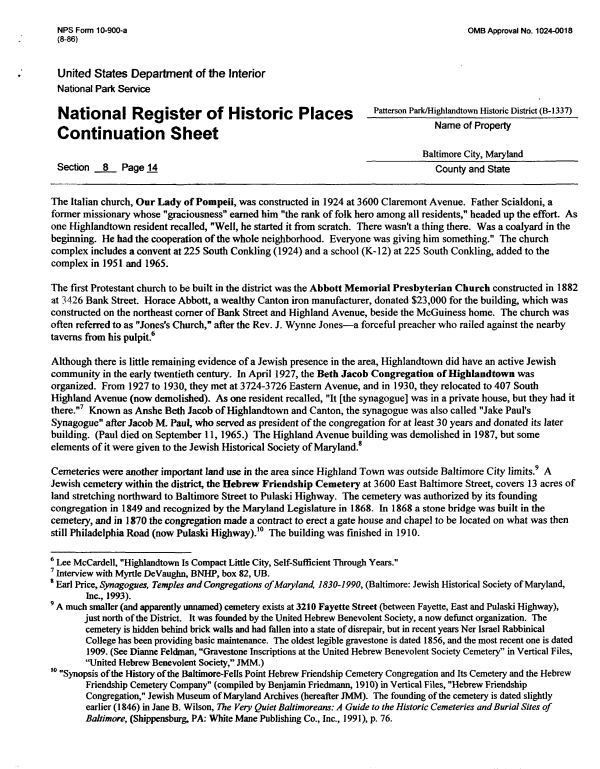 |
||||
|
DEPARTMENT OF HOUSING AND COMMUNITY DEVELOPMENT, MARYLAND HISTORICAL TRUST (Historic Sites Survey) var.d. MSA SE16-3 Image No: se16-3-0109 Enlarge and print image (91K) |
 |
||||
|
DEPARTMENT OF HOUSING AND COMMUNITY DEVELOPMENT, MARYLAND HISTORICAL TRUST (Historic Sites Survey) var.d. MSA SE16-3 Image No: se16-3-0109 Enlarge and print image (91K) |
| NPS Form 10-900-a (8-86) OMB Approval No. 1024-0018 United States Department of the Interior National Park Service of Historic Continuation Sheet Section 8 Page 14 Patterson Park/Highlandtown Historic District (B-1337) Name of Property _______Baltimore City, Maryland ______ County and State The Italian church, Our Lady of Pompeii, was constructed in 1924 at 3600 Claremont Avenue. Father Scialdoni, a former missionary whose "graciousness" earned him "the rank of folk hero among all residents," headed up the effort. As one Highlandtown resident recalled, "Well, he started it from scratch. There wasn't a thing there. Was a coalyard in the beginning. He had the cooperation of the whole neighborhood. Everyone was giving him something." The church complex includes a convent at 225 South Conkling (1924) and a school (K-12) at 225 South Conkling, added to the complex in 1951 and 1965. The first Protestant church to be built in the district was the Abbott Memorial Presbyterian Church constructed in 1882 at 3426 Bank Street. Horace Abbott, a wealthy Canton iron manufacturer, donated $23,000 for the building, which was constructed on the northeast corner of Bank Street and Highland Avenue, beside the McGuiness home. The church was often referred to as "Jones's Church," after the Rev. J. Wynne Jones—a forceful preacher who railed against the nearby taverns from his pulpit.6 Although there is little remaining evidence of a Jewish presence in the area, Highlandtown did have an active Jewish community in the early twentieth century. In April 1927, the Beth Jacob Congregation of Highlandtown was organized. From 1927 to 1930, they met at 3724-3726 Eastern Avenue, and in 1930, they relocated to 407 South Highland Avenue (now demolished). As one resident recalled, "It [the synagogue] was in a private house, but they had it there."7 Known as Anshe Beth Jacob of Highlandtown and Canton, the synagogue was also called "Jake Paul's Synagogue" after Jacob M. Paul, who served as president of the congregation for at least 30 years and donated its later building. (Paul died on September 11,1965.) The Highland Avenue building was demolished in 1987, but some elements of it were given to the Jewish Historical Society of Maryland.8 Cemeteries were another important land use in the area since Highland Town was outside Baltimore City limits.9 A Jewish cemetery within the district, the Hebrew Friendship Cemetery at 3600 East Baltimore Street, covers 13 acres of land stretching northward to Baltimore Street to Pulaski Highway. The cemetery was authorized by its founding congregation in 1849 and recognized by the Maryland Legislature in 1868. In 1868 a stone bridge was built in the cemetery, and in 1870 the congregation made a contract to erect a gate house and chapel to be located on what was then still Philadelphia Road (now Pulaski Highway).10 The building was finished in 1910. 6 Lee McCardell, "Highlandtown Is Compact Little City, Self-Sufficient Through Years." 7 Interview with Myrtle DeVaughn, BNHP, box 82, UB. * Earl Price, Synagogues, Temples and Congregations of Maryland, 1830-1990, (Baltimore: Jewish Historical Society of Maryland, Inc., 1993). 9 A much smaller (and apparently unnamed) cemetery exists at 3210 Fayette Street (between Fayette, East and Pulaski Highway), just north of the District. It was founded by the United Hebrew Benevolent Society, a now defunct organization. The cemetery is hidden behind brick walls and had fallen into a state of disrepair, but in recent years Ner Israel Rabbinical College has been providing basic maintenance. The oldest legible gravestone is dated 1856, and the most recent one is dated 1909. (See Dianne Feldman, "Gravestone Inscriptions at the United Hebrew Benevolent Society Cemetery" in Vertical Files, "United Hebrew Benevolent Society," JMM.) 10 "Synopsis of the History of the Baltimore-Fells Point Hebrew Friendship Cemetery Congregation and Its Cemetery and the Hebrew Friendship Cemetery Company" (compiled by Benjamin Friedmann, 1910) in Vertical Files, "Hebrew Friendship Congregation," Jewish Museum of Maryland Archives (hereafter JMM). The founding of the cemetery is dated slightly earlier (1846) in Jane B. Wilson, The Very Quiet Baltimoreans: A Guide to the Historic Cemeteries and Burial Sites of Baltimore, (Shippensburg, PA: White Mane Publishing Co., Inc., 1991), p. 76. |